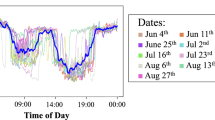Abstract
Online traffic state identification plays an important role in achieving the potentials promised by Intelligent Transportation Systems (ITS) on various traffic applications, e.g., real time traffic monitoring systems. Traditional approaches have shown the limitations in either obtaining the necessary pre-determined information or having difficulties in their online implementation. This paper introduces an online agglomerative clustering procedure for freeway traffic state identification using ITS data, represented by three traffic condition variables of flow rate, speed, and occupancy. An optimal fit of the statistical characteristics is provided by maximizing the intra-cluster data point distances and minimizing inter-cluster data point distances through a joint utilization of the Bayesian Information Criterion and the ratio of change of the dispersion measurements. Test results show that the identified freeway traffic states through the proposed procedure are reasonable and consistent with the common understandings on freeway traffic operating conditions.
Similar content being viewed by others
References
Bacher, J., Wenzig, K., and Vogler, M. (2005). SPSS twostep cluster — A first evaluation, http://www.statisticalinnovations.com/products/twostep.pdf, accessed in May, 2005.
Banks, J. (1999). “Investigations of some characteristics of congested flow.” Transportation Research Record: Journal of the Transportation Research Board, Transportation Research Board of the National Academies, No. 1678, pp. 128–134.
Chiu, T., Fang, D., Chen, J., Wang, Y., and Jeris, C. (2001). “A robust and scalable clustering algorithm for mixed type attributes in large database environment.” Proceedings of the 7 th ACM SIGKDD International Conference on Knowledge Discovery and Data Mining, San Francisco, California, pp.263–268.
Coifman, B. (2001). “Improved velocity estimation using single loop detectors.” Transportation Research Part A, Vol. 35, No. 10, pp. 863–880.
Guo, J., Xia, J., and Smith, B. (2009). “A kalman filter approach to speed estimation using single loop detector measurements under congested conditions.” Journal of Transportation Engineering, ASCE, Vol. 135,Issue 12, pp. 927–934.
Hall, F., Hurdle, V., and Banks, J. (1992). “Synthesis of recent work on the nature of speed-flow and flow-occupancy (or density) relationships on freeways.” Transportation Research Record: Journal of the Transportation Research Board, Transportation Research Board of the National Academies, No. 1365, pp. 12–18.
Kerner, B. S. and Rehborn, H. (1996). “Experimental properties of complexity in traffic flow.” Physical Review, Vol. E53, No. 5, pp. R4275–R4278.
Lomax, T., Turner, S., and Margiotta, R. (2004). Monitoring urban roadways in 2002: Using archived operations data for reliability and mobility measurement. FHWA Report, No. FHWA-HOP-04-011, FHWA.
Ma, J. and Kockelman, K. (2005). “Crash modeling using clustered data from washington state: Prediction of optimal speed limits.” Proceedings of the 84th Annual Meeting of Transportation Research Board, Transportation Research Board of the National Academies, Washington, D.C.
Park, B. (1998). “Clustering-based RBF neural network model for shortterm freeway traffic volume forecasting.” Proceedings of the 5th International Conference on Applications of Advanced Technologies in Transportation Engineering, Newport Beach, California, pp. 280–287.
Park, B. (2002). “Hybrid neuro-fuzzy application in short-term freeway traffic volume forecasting.” Transportation Research Record: Journal of the Transportation Research Board, Transportation Research Board of the National Academies, No. 1802, pp.190–196.
Schwarz, G. (1978). “Estimating the dimension of a model.” The Annals of Statistics, Vol. 6, No. 2, pp. 461–464.
Sheu, J. (2002). “A fuzzy clustering-based approach to automatic freeway incident detection and characterization.” Fuzzy Sets and Systems, Vol. 128,Issue 3, pp. 377–388.
TRB. (2000). Highway capacity manual, Special Report 209, Transportation Research Board of the National Academies, Washington, D.C.
Xia, J. and Chen, M. (2005). “Analyzing traffic flow phases using ITS data.” Proceedings of the 84 th Annual Meeting of Transportation Research Board, Transportation Research Board of the National Academies, Washington, D.C.
Xia, J. and Chen, M. (2007). “A nested clustering procedure for traffic condition classification.” Journal of Computed-Aided Civil and Infrastructure Engineering, Vol. 22, No. 6, pp. 430–437.
Author information
Authors and Affiliations
Corresponding author
Rights and permissions
About this article
Cite this article
Xia, J., Huang, W. & Guo, J. A clustering approach to online freeway traffic state identification using ITS data. KSCE J Civ Eng 16, 426–432 (2012). https://doi.org/10.1007/s12205-012-1233-1
Received:
Revised:
Accepted:
Published:
Issue Date:
DOI: https://doi.org/10.1007/s12205-012-1233-1




